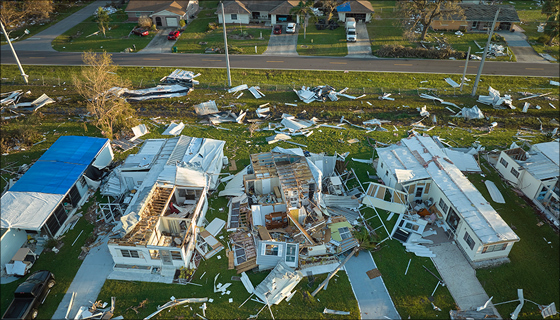
Almost everyone thinks they know what risks are associated with a property just by looking at it. Certainly, visuals give you a good idea of what you can see. Neglected siding, poor landscaping, and damaged roofs are clear indicators of property damage and poor maintenance. Clearly, there are risks in purchasing real estate in disrepair. But what about the risks you can’t see?
What is Property Risk?
Both mother nature and manmade risks can directly affect a property. Natural disasters like wildfires, floods, tornados, hurricanes, lightning, and losses caused by humans through crime, superfund sites, and underground storage tanks all contribute to risk. All of these and more are types of property risks that can’t be seen, and more importantly, that very few people know about in advance.
Examples (Types) of Property Risks
People don’t choose to live in places that are thought of as “risky.” They choose to live in places close to work, away from other people, near the water, on a hillside with a view, or simply where they can afford. All of these can be risky places that exhibit potential “property risks.”
-
The person near the water is exposed to flood risk.
-
The person on the hillside can see a wildfire.
-
Close to work in an urban area may mean crime or toxic facility risk.
-
Homeowners who choose to live away from other people may mean they have no fire protection.
Risks may sound easily avoidable, but in fact, they are in most places we would consider occupancy.
Property Risk Assessment and Calculation
Risks are fairly consistent. They tend to happen in the same places over and over again. Also, humans tend to be pretty ignorant of, and uneducated about, risks.
-
Places that flood, flood.
-
Places that burn in a wildfire, burn in a wildfire.
-
Hurricanes come on shore, where hurricanes come on shore.
These things are known, and they are fairly consistent.
The first step in any risk assessment, and ultimately risk management, is understanding the available information, where it comes from, and how it can be applied.
Fortunately, for U.S. residents, federal and state governments do a great job of collecting tons of risk and hazard information. Unfortunately, most of it is not fit for human consumption. You can’t get a property risk assessment from your tax dollars. Since properties are tied to the earth, a geospatial analysis of risk works well. There are thousands of geospatial data sets that each provide part of an answer. In the correct hands with professional risk analytics, these databases with risk data for assessment can be modeled to produce an accurate risk estimate for an event. Repeat this process hundreds of times and you have a fairly comprehensive examination of risk for a location.
Once all of the data layers are built, it’s a matter of data retrieval and updating. Risk answers are great, but they don’t mean much if they are outdated. That’s why the cutting-edge process of dynamic risk scoring allows for the constant updating of the underlying risk data to ensure that the end user always receives the most up-to-date answer possible. Eventually, this data can be used for comprehensive property purposes like underwriting insurance coverages and determining property values.
Strategies for Mitigating Property Risk
The best strategy for mitigating property risk is fairly simple: don’t live in or own commercial real estate in risky areas. Not exposing yourself to risk is the best way to avoid it. With that said, people like to live near the water, on a hillside, away from other people, or some combination thereof. But they don’t have to be ignorant of the risks they are choosing.
The first step in the mitigation of risk is to know what to mitigate against
If I live on top of the hill but am mitigating for flooding, that’s probably a wasted effort. But if I’m mitigating for wildfire, that’s probably a good effort.
The easiest way to determine what risks you are exposed to is to view the data provided at www.freehomerisk.com. It’s a publicly available website that provides the risk industry’s best risk information for free in an easy-to-understand report. If you’ve ever gotten a report card in school, you’ll easily understand it.
The second step in the mitigation of risk is to do something
There are a lot of hazards that require property owners to mitigate against. Fortunately, most properties are not subject to every risk. And there are some risks, like sinkholes, that really don’t have any mitigation steps that can be taken, other than the property owner not owning property in the area where these risks are prevalent. A quick search at www.freehomerisk.com will identify the risks that your property is exposed to so you can take appropriate action to mitigate against those risks.
What is the Role of P&C Insurance in Managing Property Risk?
Insurance is the single greatest invention in terms of risk mitigation. But having an insurance policy does not protect you from the risk. It protects you financially and it allows you to recover, but it can’t defend against the threat of a property risk from happening.
However, P&C insurance companies can educate their customers by helping them understand their risks and how to mitigate those risks. This is also a benefit to P&C insurers who receive a much higher return on investment if claims do not have to be paid.
Large insurers have been using hazard risk data for 20 years or more to help with property risk management. Thanks to HazardHub, every insurer, agency, and broker can now have access to valuable property risk information not only from a policy writing standpoint but also from a customer education perspective. We all know that the best insurance customer is one who never makes a claim. Here’s an opportunity for insurers to help their customers with better, proven information, and for insurers to have fewer claims to handle. It’s a win-win for everyone.